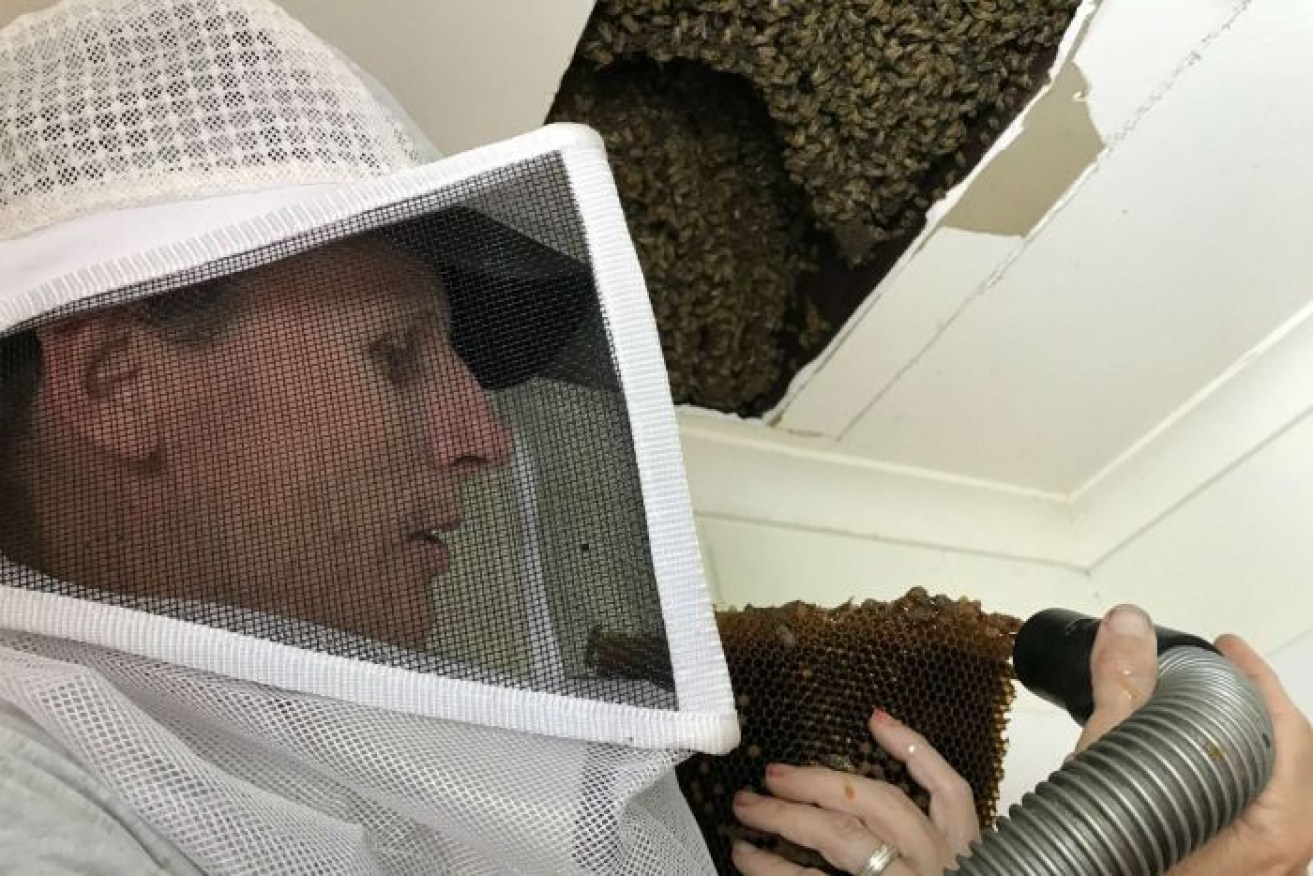Apiarist strikes gold finding more than 50,000 bees in a bathroom

Scott Whittaker uses a vacuum to safely transfer the bees to a special hive for relocation. Photo: ABC Rural/Jennifer Nichols
When Scott Whittaker started cutting into the ceiling of a Sunshine Coast house he had no idea he was about to encounter what “could only be described as a monster”, the largest colony of bees he has ever removed from a home.
So the Hinterland Bees apiarist filmed the fascinating procedure.
More than 50,000 bees had packed the ceiling of a bathroom with so much honeycomb that it took him nearly twelve physically-demanding hours to save and relocate the colony.
Just as he thought he was getting to the end, Mr Whittaker discovered honey stores that went back another 1.2 metres, dripping down onto his worksite — ladder in a shower cubicle.
He has been run off his feet since June, collecting wild swarms and cutting more than 30 bee hives from the cavities of homes on Queensland’s Sunshine Coast.
As Australians become more aware of the value of bees in the environment, demand for services like his has been booming.
It was the third hive he had cut out of a ceiling in one week, “which is starting to wear me out a bit,” Mr Whittaker laughed.
“It’s quite nice when they’re down nice and low in the wall and you can sit on a milk crate and cut them out that way. But when you’re working in the ceiling it is a bit of a contortion job.”
He works without gloves and said that bees are not aggressive, just defensive.

Vicki Arthur and her boarder Kyle Stiller joke that bee stings came with living in their home. Photo: ABC Rural/Jennifer Nichols
Vicki Arnold lived with the bees for over three years after seeing the original swarm enter a hole in the exterior wall of her Nambour home.
“A few people told us they’d go away, we’ve all been stung,” Ms Arnold said.
“It’s always ‘fun’ when you finish work and you turn your light on and the bees come flying into the room.”
Ms Arnold’s mother tried calling a number of beekeepers before Mr Whittaker agreed to take on the challenge, arriving with an angle grinder, ladder and vacuum machinery to get to work.
He uses a thermal imager to identify the location of the brood nests, which the bees regulate at around 34 degrees Celsius, before exposing the hive and safely sucking the bees into a standard hive box with his industrial vacuum.

Hinterland Bees Scott Whittaker has been receiving multiple calls every week to extract bee hives from homes and collect swarms. Photo: ABC Rural/ Jennifer Nichols
Where’s Queeny?
The key to speeding up the operation is tracking down the queen amongst thousands of worker bees and placing her into a small cage.
“Queens live for anywhere up to five years and once I find the queen I can work a lot quicker. I put her in a little cage and they won’t abandon her,” Mr Whittaker said.
“The female worker bees live for about six weeks and just work themselves to death, basically, for the sake of the hive. They’re very altruistic in that way.”

This dark honeycomb shows the age of the bee colony that moved into the ceiling above the shower three years ago. Photo: ABC Rural/Jennifer Nichols
The brood comb full of eggs and larvae and pupae is removed and attached to standard bee hive frames with rubber bands.
“Once I’ve removed everything from inside here I set the hive up out near where the original entrance is, block off the original entrance, and then all the returning foraging bees will go into the hive box that I’ve set up there,” he said.
The bees were then taken back to his North Maleny property to remain in quarantine for three months.
“Everyone’s been growing aware of the potential decline of honey bees across the world,” Mr Whittaker said.








